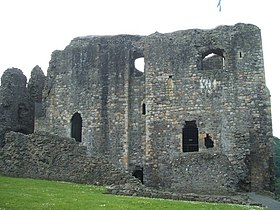‘Monday, November I.
Though Dr. Johnson was lazy, and averse to move, I insisted that he should go with me, and pay a visit to the Countess of Eglintoune, mother of the late and present earl. I assured him, he would find himself amply recompensed for the trouble; and he yielded to my solicitations, though with some unwillingness...
As we passed very near the castle of Dundonald, which was one of the many residences of the kings of Scotland, and in which Robert the Second lived and died, Dr. Johnson wished to survey it particularly. It stands on a beautiful rising ground, which is seen at a great distance on several quarters, and from whence there is an extensive prospect of the rich district of Cuninghame, the western sea, the isle of Arran, and a part of the northern coast of Ireland. It has long been unroofed ; and, though of considerable size, we could not, by any power of imagination, figure it as having been a suitable habitation for majesty. Dr. Johnson, to irritate my old Scottish enthusiasm, was very jocular on the homely accommodation of ' King Bob,' and roared and laughed till the ruins echoed..’
Dr. Johnson and James Boswell are on their leg home at the end of their trip to the Western Isles on November 1st, 1773. “King Bob’s” dying place, which he had built in 1371, is provided with a few more historical facts and much more seriousness in Walter Scott’s treatment, in his “The History of Scotland”.
‘The regent, after he had been invested with his office, showed considerable energy. The earl of Nottingham, marshal of England, trusted with the wardenship of the east marches, had reproached the Percies for their defeat at Otterbourne, and boasted of what he would himself have done in similar circumstances. But when the regent Robert, at the head of an equal army, defied him to action, Nottingham declined the combat with the unsoldier-like excuse, " that he was not commissioned to expose the king's liege subjects to danger." The Scots burned Tynemouth, and returned to their own country. . In the summer of the same year, 1389, a truce of three years was formed betwixt France and England, in which Scotland was included as the ally of the former power. Shortly after this event king Robert II died at his castle of Dundonald in Ayrshire. He was at the advanced age of seventy-five, and had reigned nineteen years.’

No comments:
Post a Comment
Note: Only a member of this blog may post a comment.